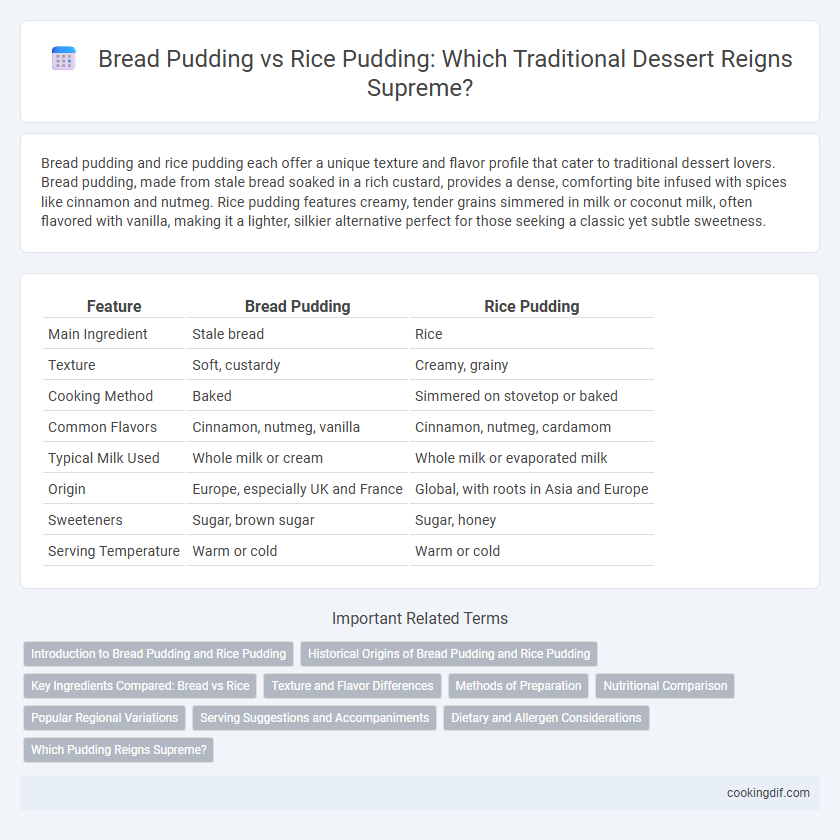Bread pudding and rice pudding each offer a unique texture and flavor profile that cater to traditional dessert lovers. Bread pudding, made from stale bread soaked in a rich custard, provides a dense, comforting bite infused with spices like cinnamon and nutmeg. Rice pudding features creamy, tender grains simmered in milk or coconut milk, often flavored with vanilla, making it a lighter, silkier alternative perfect for those seeking a classic yet subtle sweetness.
Table of Comparison
| Feature | Bread Pudding | Rice Pudding |
|---|---|---|
| Main Ingredient | Stale bread | Rice |
| Texture | Soft, custardy | Creamy, grainy |
| Cooking Method | Baked | Simmered on stovetop or baked |
| Common Flavors | Cinnamon, nutmeg, vanilla | Cinnamon, nutmeg, cardamom |
| Typical Milk Used | Whole milk or cream | Whole milk or evaporated milk |
| Origin | Europe, especially UK and France | Global, with roots in Asia and Europe |
| Sweeteners | Sugar, brown sugar | Sugar, honey |
| Serving Temperature | Warm or cold | Warm or cold |
Introduction to Bread Pudding and Rice Pudding
Bread pudding and rice pudding are classic traditional desserts celebrated for their comforting textures and rich flavors. Bread pudding combines stale bread soaked in a custard mixture of eggs, milk, sugar, and spices, baked until golden and soft, often enhanced with raisins or nuts. Rice pudding features cooked rice simmered in milk or cream with sugar and aromatic spices like cinnamon or vanilla, producing a creamy, smooth dessert loved worldwide.
Historical Origins of Bread Pudding and Rice Pudding
Bread pudding traces its origins to 11th-century England, where it emerged as a frugal way to use stale bread combined with eggs and milk to create a comforting dessert. Rice pudding, with roots dating back to ancient civilizations in Asia and the Middle East, was traditionally made by simmering rice in milk and sweetening it with sugar or honey. Both desserts reflect regional resourcefulness and cultural adaptation, highlighting staple ingredients like bread and rice transformed into beloved traditional sweets.
Key Ingredients Compared: Bread vs Rice
Bread pudding utilizes stale or day-old bread soaked in a mixture of eggs, milk, sugar, and spices, creating a rich, custardy texture with a slightly chewy bite. Rice pudding features cooked rice simmered with milk, sugar, and often cinnamon or vanilla, resulting in a creamy, smooth consistency with tender grains. The key ingredient distinction impacts both texture and flavor, with bread offering a denser, more absorbent base, while rice provides a delicate, lighter, and creamier dessert experience.
Texture and Flavor Differences
Bread pudding offers a dense, custard-soaked texture with rich, caramelized flavors from baked bread and spices, creating a warm and hearty dessert experience. Rice pudding features a creamy, smooth consistency with tender rice grains infused with sweet vanilla or cinnamon notes, delivering a lighter and more delicate taste. These texture and flavor differences highlight bread pudding's indulgent richness versus rice pudding's soft, comforting simplicity in traditional desserts.
Methods of Preparation
Bread pudding is prepared by soaking cubed bread in a custard mixture of milk, eggs, sugar, and spices before baking until golden and set. Rice pudding involves simmering rice in milk with sugar and flavorings like cinnamon or vanilla until the mixture thickens into a creamy consistency. Both desserts rely on slow cooking techniques, but bread pudding is baked while rice pudding is typically cooked on the stovetop or baked softly.
Nutritional Comparison
Bread pudding and rice pudding offer distinct nutritional profiles, with bread pudding typically higher in carbohydrates and calories due to enriched bread and added sugar content. Rice pudding provides a lower-fat alternative, often rich in minerals like manganese and selenium, while also delivering moderate protein from the rice and dairy base. Both desserts contain essential vitamins such as B-complex, but bread pudding may have increased saturated fats depending on butter and cream usage, influencing overall nutritional impact.
Popular Regional Variations
Bread pudding, a traditional dessert popular in the Southern United States and the United Kingdom, features stale bread soaked in a custard mixture and baked with spices like cinnamon and nutmeg. Rice pudding, favored in South Asia and Latin America, consists of simmered rice cooked with milk, sugar, and flavorings such as cardamom or vanilla. Regional variations include the addition of dried fruits and rum in Caribbean bread pudding, while rice pudding is often enriched with saffron and rose water in Middle Eastern cuisines.
Serving Suggestions and Accompaniments
Bread pudding pairs exceptionally well with warm caramel or bourbon sauce, enhancing its dense, custardy texture and rich flavors, often complemented by a scoop of vanilla ice cream or fresh berries. Rice pudding benefits from a sprinkling of cinnamon or nutmeg and is typically served chilled or at room temperature, making it a refreshing end to a meal when accompanied by tropical fruits or a dollop of whipped cream. Both desserts shine with complementary sauces and toppings that elevate their traditional appeal and provide diverse serving options.
Dietary and Allergen Considerations
Bread pudding often contains gluten and may include eggs and dairy, requiring caution for individuals with celiac disease, egg allergies, or lactose intolerance. Rice pudding typically uses rice, milk, sugar, and cinnamon, making it a gluten-free alternative, though it still contains dairy. Both desserts can be adapted for dietary restrictions by using gluten-free bread or plant-based milks to accommodate allergen sensitivities.
Which Pudding Reigns Supreme?
Bread pudding and rice pudding each offer unique textures and flavors, but bread pudding reigns supreme in traditional dessert popularity due to its rich, custardy base and versatility with ingredients like raisins, cinnamon, and caramel sauces. Rice pudding, while creamy and comforting with its soft grain and vanilla-spiced profile, tends to be lighter and less indulgent than bread pudding. The dense, hearty characteristics of bread pudding consistently captivate dessert enthusiasts seeking a more substantial and decadent experience.
Bread Pudding vs Rice Pudding for traditional dessert Infographic

 cookingdif.com
cookingdif.com